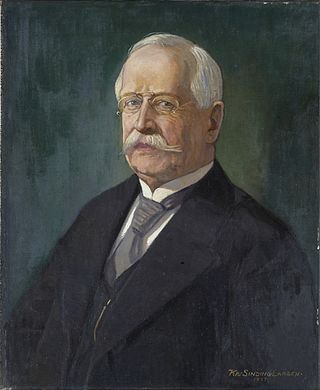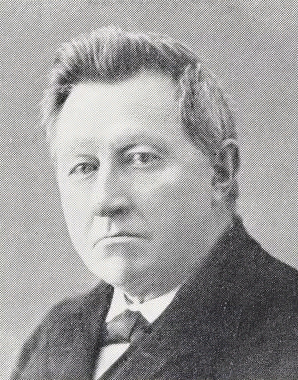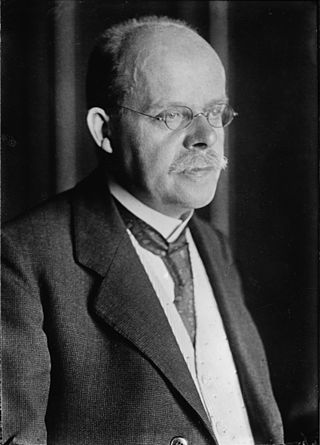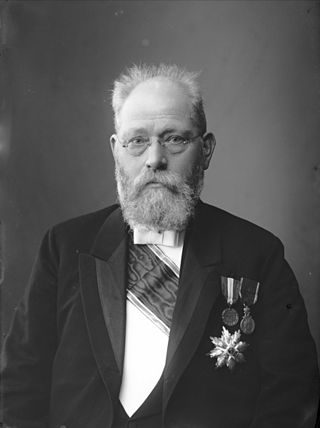
The Cabinet of the United Kingdom is the senior decision-making body of His Majesty's Government. A committee of the Privy Council, it is chaired by the Prime Minister and its members include Secretaries of State and other senior ministers. Members of the Cabinet are appointed by the Prime Minister and are by convention chosen from members of the two houses of the Parliament of the United Kingdom, the House of Commons and the House of Lords. The Cabinet is now made up almost entirely of members of the House of Commons.

Otto August Strandman was an Estonian politician, who served as prime minister (1919) and State Elder of Estonia (1929–1931). He was one of the leaders of the centre-left Estonian Labour Party, that saw its biggest support after the 1919 and 1920 elections. Strandman was a key figure in composing the radical land reform law and the 1920 Constitution. He also served as Minister of Agriculture (1918–1919), Minister of Justice, Minister of Finance (1924), Minister of Foreign Affairs and Minister of War (1919). While he was holding the office of the Minister of Finance, he stabilized the economy and managed to avoid hyperinflation. Strandman served as the speaker of the Estonian Provincial Assembly in 1917–1918, and as speaker of the newly independent country's parliament (Riigikogu) in 1921. He was also a diplomat, serving as the Estonian envoy in Warsaw, Poland (1927–1929), and in Paris, France (1933–1939).

Otto Albert Blehr was a Norwegian statesman, attorney and newspaper editor who was the 8th prime minister of Norway from 1902 to 1903 during the Union between Sweden and Norway and from 1921 to 1923 following the Dissolution of the union between Norway and Sweden. He represented the Liberal Party.

The Liberal Party is a centrist political party in Norway. It was founded in 1884 and it is the oldest political party in Norway. It is positioned in the centre on the political spectrum, and it is a liberal party which has over the time enacted reforms such as parliamentarism, freedom of religion, universal suffrage, and state schooling.

The Minister of Foreign Affairs is a councilor of state and chief of the Norway's Ministry of Foreign Affairs. Since 16 October 2023, the position has been held by Espen Barth Eide of the Labour Party.

Karl Rudolf Heinze was a German jurist and politician. During the Weimar Republic, as a member of the right-of-centre German People's Party (DVP) he was vice-chancellor of Germany and minister of Justice in 1920/21 in the cabinet of Konstantin Fehrenbach and from 1922 to 1923 again minister of Justice under Wilhelm Cuno.

Olaf Amundsen was a Norwegian lawyer and politician for the Liberal Party.

Arnold Holmboe was a Norwegian politician for the Liberal Party. He was mayor of Tromsø, two-term member of the Norwegian Parliament as well as Minister of Justice from 1922 to 1923 and Minister of Finance from 1924 to 1926.

Fredrik Anton Martin Olsen Nalum was a Norwegian educator and politician for the Liberal Party. He held three different government minister posts, served as mayor and was a six-term member of Parliament.

Ole Anton Qvam was a Norwegian lawyer and Liberal politician, who was the Norwegian minister of Justice 1891–1893, 1898–1899 and 1900–1902, minister of the Interior 1899–1900, as well as head of the ministry of Auditing, ministry of Agriculture and ministry of Justice in 1900, and Norwegian prime minister in Stockholm 1902–1903.

Bahr Halvorsen's Second Cabinet governed Norway between 6 March 1923 and 30 May 1923. It ceased to exist after the death of Prime Minister Otto Bahr Halvorsen. It had the following composition:
Events in the year 1923 in Norway.
Events in the year 1903 in Norway.

Eivind Stenersen Blehr was a Norwegian minister in the NS government of Vidkun Quisling, from 1942 to 1944. In the Norwegian post-war legal purges he was convicted of treason and sentenced to 20 years of forced labour. He was the son of former prime minister Otto Blehr and feminist Randi Blehr.

Randi Marie Blehr was a Norwegian feminist, liberal politician, suffragist, peace activist and women's rights activist. She was married to Prime Minister of Norway Otto Blehr, and was therefore addressed as "Madam Prime Minister" during her lifetime. She was one of the preeminent leaders of the Norwegian women's rights movement from the 1880s and co-founded the Norwegian Association for Women's Rights, serving as its President from 1895 to 1899 and from 1903 to 1922. She also initiated the establishment of the Norwegian Women's Public Health Association that grew to become a humanitarian organisation with 250,000 members. She was a leading advocate of Norwegian independence from Sweden and took on representative duties for Norway during her husband's tenure as Prime Minister.

The Minister of Agriculture and Food is a councilor of state and chief of the Norway's Ministry of Agriculture and Food. The ministry is responsible for issues related to agriculture, forestry and food. Major subordinate agencies include the Norwegian Agriculture Authority, the Norwegian Food Safety Authority and Statskog. The position was created on 31 March 1900, along with the ministry, and Ole Anton Qvam was the inaugural officeholder. Fifty people from eight parties have held the office. During the German occupation of Norway from 1940 to 1945, the office was both held by a German puppet government and an elected government in London.

The first Marx cabinet, headed by Wilhelm Marx of the Centre Party, was the tenth democratically elected government during the Weimar Republic. It took office on 30 November 1923 when it replaced the Second Stresemann cabinet, which had resigned on 23 November after the Social Democratic Party (SPD) withdrew from the coalition. Marx's new cabinet was a minority coalition of three centre to centre-right parties.

Wollert Konow was a Norwegian politician and farmer.

Berge's Cabinet was the government of Norway from 30 May 1923 to 25 July 1924. The cabinet was led by Prime Minister Abraham Berge. It succeeded Otto Bahr Halvorsen's second cabinet following his death, and was composed of mostly the same ministers as its predecessor. The cabinet resigned on 23 July 1924, with effect two days later, after not getting wide support in the Storting for a alcohol ban. It was succeeded by Johan L. Mowinckel's first cabinet.

Knudsen's Second Cabinet was the government of Norway from 31 January 1913 to 21 June 1920, led by prime minister Gunnar Knudsen. It was a Liberal Party minority government. It was formed following Jens Bratlie's defeat in the 1912 election.

















